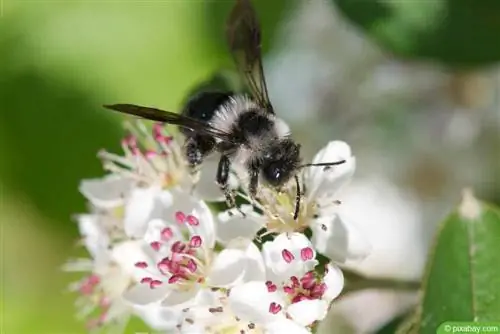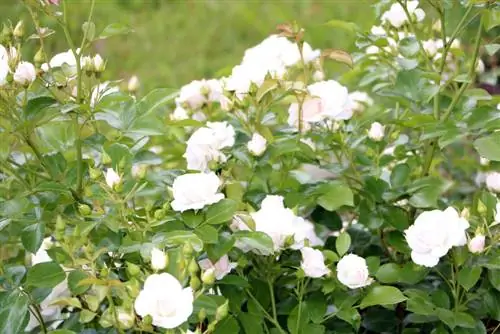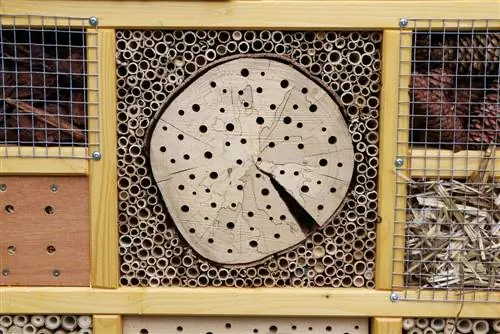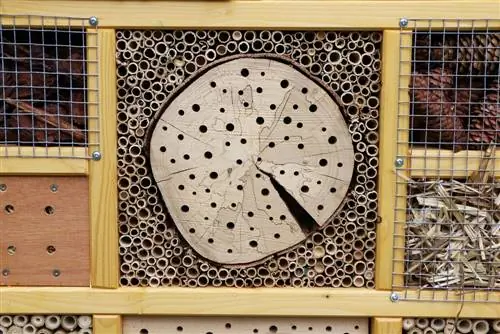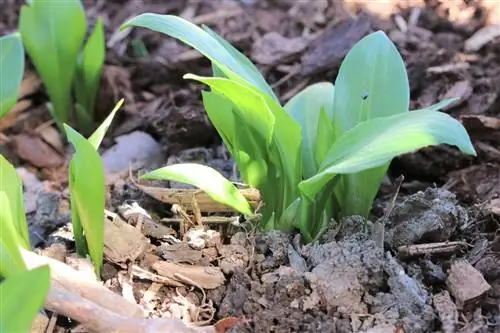- Author admin [email protected].
- Public 2023-12-17 03:39.
- Last modified 2025-01-24 12:45.
The “mother of all carrots” is the wild carrot (Latin Daucus carota), which grows wild in poor meadows, on field and roadsides - and has been very versatile in both cooking and medicine for thousands of years is used.
Profile
- Botanical name: Daucus carota subsp. carota
- Plant family: Apiaceae (Umbelliferae)
- Popular names: yellow turnip, moor (hence also “carrot”)
- Origin and distribution: widespread in Europe, North Africa and Asia Minor
- Locations: on poor meadows, on the edges of fields and meadows
- Annual or perennial: biennial, flowers only appear in the second year
- Growth: herbaceous, rosette-like, flower stalk upright
- Growth height: between 40 and 80 centimeters
- Roots: Deep-rooted with thickened main root
- Leaf: fine, pinnate, green
- Flowers: cruciferous flowers in umbels, white with black “eye”
- Flowering period: June to September
- Location: loamy, humus-rich soils with low to normal nutrient content
- Propagation: direct sowing in spring
- Germination: cold germinator
- Care: keep sufficiently moist (but not wet!), fertilize occasionally (not absolutely necessary in humus-rich soils); Mixed crops with onions
- Harvest: roots in late summer, seeds, leaves and flowers
- Ingredients: carotenoids, essential oils (especially in the seeds), falcarinol (also carotatoxin, can prevent the development of cancer), mono- and oligosaccharides, fiber, vitamins (B group, C)
- Confusion: poisonous umbelliferous plants such as hemlock or dog parsley
Tip:
When collecting wild carrots, you can distinguish them from similar-looking poisonous plants using two characteristics. Firstly, both the leaves and flowers smell strongly of carrot - while hemlock and parsley give off a more ammonia-like, unpleasant smell. In addition, female carrot flowers are not white in the middle, but black - no other umbelliferous family has this feature.
Use
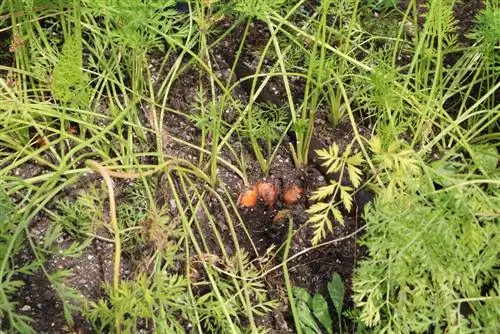
The wild carrot has been used by humans for thousands of years. During archaeological excavations, the seeds of the plant were found in some Stone Age pile dwellings, which shows that they were already used by hunters and gatherers in the earliest epoch of human history. Today, wild vegetables have unfortunately been somewhat forgotten, which is probably due to the easier availability of cultivated varieties. Nevertheless, the wild carrot contains many he althy substances, it is also easy to digest and tastes sweeter and milder than the typical supermarket carrot.
Tip:
The wild carrot is not available in the supermarket. You can collect them in nature - or if collecting is too laborious for you or too dangerous because of the risk of confusion with other poisonous umbelliferous plants, you can grow them in your own garden.
The wild carrot in medicine
All important ancient and medieval authors described the carrot as a medicinal plant. Today there are numerous cultivated forms of the plant, although the roots are colored yellow, orange or violet. The roots of the wild carrot, on the other hand, are white and they also look very similar to parsley roots. Traditionally, not only the roots, but also the seeds, leaves and flowers of the wild carrot are used. Carrot seed oil, which contains valuable essential oils in a very high concentration, was (and still is) used in medicine in particular. These are said to have a pain-relieving and anti-inflammatory effect.
Uses for skin
For example, carrot seed oil is ideal for use in dermatology, as it is said to relieve eczema and other skin rashes. Various ointments and creams with carrot seed oil are available commercially, but you can also make them yourself.
Make your own carrot seed oil
Carrot seed oil is easy to make yourself as an extract. All you have to do is collect the seeds of the wild carrot and dry them thoroughly, for example by spreading them loosely in a warm and dark place. Then roughly crush these seeds, then pour them into a well-sealable container and pour in a high-quality vegetable oil. For example, rapeseed, almond or olive oil is suitable for this. Leave the mixture in a warm (but not more than 40 ° C) and dark place for about four to five weeks, shaking it daily. You can then strain the carrot seed oil through a fine sieve or cloth to remove any solids. You can use the oil pure both internally and externally or use it as a base oil for a homemade cream.
Wild carrot for the intestines
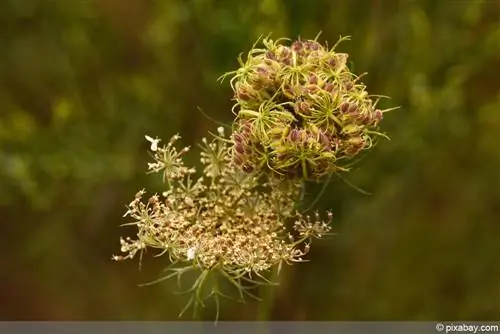
In addition to the positive effect on the skin, wild carrots are also said to have urinary and wind-driving effects. Both the root and the oil are said to help against flatulence and painful colic, and the raw, finely grated carrot has also been proven to be excellent against diarrhea. So it's no wonder that the pediatrician Ernst Moro (the same person after whom the Moro reflex in infants was named) developed a recipe for carrot soup that is still in use today at the beginning of the 20th century.
The wild carrot can have this effect because it contains numerous constipating pectins (which is why grated apples, for example, also help against diarrhea). In addition, when the vegetables are heated, so-called oligogalacturonic acids are created, which drive the bacteria out of the intestine - the pathogens can then no longer adhere to the receptors on the intestinal wall because the oligogalacturonic acids are faster.
Recipe
Moro carrot soup for diarrheal illnesses
Ingredients:
- 500 grams of peeled and sliced carrots
- one liter of water
- Meat broth (homemade)
- a level teaspoon of s alt
Preparation
Boil the peeled and sliced wild carrots in water for about an hour. Now puree them thoroughly and top up the liquid reduced by heating with nutritious meat broth so that you get it back to one liter. Finally, stir in a level teaspoon of s alt. This is important because the body's s alt balance can fluctuate dangerously if you have diarrhea.
Wild carrot protects against cancer
Superfood doesn't have to come from exotic countries because we have it right on our doorstep and we just have to collect it. The beta-carotene contained in the wild carrot and similar substances such as lycopene and lutein have strong antioxidant effects and thus defuse certain cell toxins. This not only prevents heart attacks and strokes, but can also help prevent some types of cancer thanks to the polyines it contains. This effect has been scientifically proven in lung and larynx cancer as well as prostate cancer. To reap all the he alth benefits of wild carrots, you should eat the vegetable raw, cooked or steamed at least twice a week.
The wild carrot in the kitchen
Basically, the root of the wild carrot can be peeled and prepared like any other root vegetable. However, the yield is naturally not as high as with the much larger and thicker cultivated forms - after all, it is a natural wild vegetable that was not bred for performance. You can boil, bake, steam, fry the wild carrot, use it as an ingredient in casseroles, soups and stews or simply eat it raw, for example finely grated with other vegetables and herbs as a salad. The flowers and leaves of the plant can also be used in the kitchen, for example in soups, salads and green smoothies.
Tip:
The roots of the biennial wild carrot should only be harvested before flowering in the first year. The roots of flowering carrots become woody and taste more bitter than sweet. However, they remain edible and do not develop any toxins.
Seeds as a spice for many dishes

The dried and crushed seeds of the wild carrot are also ideal for use in the kitchen. The slightly spicy, caraway-like taste flavors soups, stews as well as homemade bread and spreads or dips.
Tip:
Collect the ripe wild carrot seeds on a dry day, preferably late morning or early afternoon. This reduces the water content, which in turn makes drying easier - and prevents later mold formation.
Recipe
Homemade wholemeal bread with wild carrot, sunflower seeds and anise seed
Ingredients:
- 300 grams of wholemeal spelled flour
- 200 grams of whole wheat flour, type 1050
- 200 grams of finely grated wild carrots
- 100 grams of sunflower seeds
- 1/2 teaspoon anise seed
- 1/2 teaspoon black pepper, freshly ground
- 1/2 teaspoon crushed carrot seeds
- 1 to 2 teaspoons of sea s alt (depending on taste)
- 1 packet of dry yeast
- Olive oil, extra virgin
Preparation
Mix the flour, yeast and spices thoroughly in a dry bowl. Add about 0.25 liters of lukewarm water - more if necessary - and knead the ingredients first with the dough hook, then with floured hands into a smooth dough. Now place the dough in a bowl, cover it with a kitchen towel and let the dough rise in a warm place for at least half an hour.
The dough should then have increased significantly. Now knead in the grated wild carrots and sunflower seeds thoroughly and then form a loaf of bread. You can also put this in a greased loaf pan. Now the bread has to rise again for at least half an hour before you put it in the oven preheated to 180 °C.
Don't forget to put a heatproof bowl of water in it. After about 40 minutes the carrot bread should be ready to bake - take it out of the tin and tap the bottom with your knuckles. If the bread sounds hollow, it is cooked and tastes delicious with butter and s alt.
Note
Pregnant womenand women withwant to have childrenshould especially eat the seeds of the wild carrotThese are said to have a contraceptive effect (the wild vegetables were actually used for contraceptive purposes in earlier times) and can also cause premature births and miscarriages.


